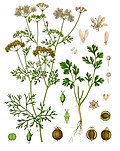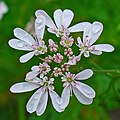Coriander
Parsley-like herb used as seasoning or garnishk; dried coriander seeds used whole or groundk; Old World herb with aromatic leaves and seed resembling parsley Coriander, also known as cilantro or Chinese parsley, is a herb that is commonly used in cooking around the world. The herb has a distinct flavor and aroma that is often described as citrusy and slightly spicy, and is used in a wide range of dishes and cuisines.
Culinary Uses[edit]
Coriander is a versatile herb that can be used in a variety of culinary applications. It is commonly used in Indian, Mexican, and Thai cuisine, among others, and is often used to add flavor and aroma to curries, soups, stews, and other dishes. Coriander can be used fresh or dried, and is often used as a garnish or seasoning. The seeds of the coriander plant are also commonly used in cooking, and are ground into a spice that is used in many different types of dishes.
Nutritional Value[edit]
Coriander is a good source of several important nutrients, including vitamins A and C, and minerals such as potassium and calcium. It also contains antioxidants and anti-inflammatory compounds, which may provide a variety of health benefits. However, some people may have an allergic reaction to coriander, and it may interact with certain medications. It is always important to consult with a healthcare professional before making any changes to your diet or taking any new supplements or herbs.
History[edit]
Coriander has been used in cooking and medicine for thousands of years, and is believed to have originated in the Mediterranean region. It was highly valued by ancient civilizations such as the Greeks, Romans, and Egyptians, who used it for its flavor and medicinal properties. Over time, coriander spread to other parts of the world, and is now widely cultivated and used in many different cuisines and cultures.
References[edit]
See also[edit]
-
Illustration of Coriandrum sativum
-
Coriandrum sativum plant
-
Chemical structure of Linalool
-
Coriander leaves
-
Coriander seeds
-
Onion Coriander Paratha
-
Coriander roots
Ad. Transform your life with W8MD's Budget GLP-1 injections from $75


W8MD offers a medical weight loss program to lose weight in Philadelphia. Our physician-supervised medical weight loss provides:
- Weight loss injections in NYC (generic and brand names):
- Zepbound / Mounjaro, Wegovy / Ozempic, Saxenda
- Most insurances accepted or discounted self-pay rates. We will obtain insurance prior authorizations if needed.
- Generic GLP1 weight loss injections from $75 for the starting dose.
- Also offer prescription weight loss medications including Phentermine, Qsymia, Diethylpropion, Contrave etc.
NYC weight loss doctor appointmentsNYC weight loss doctor appointments
Start your NYC weight loss journey today at our NYC medical weight loss and Philadelphia medical weight loss clinics.
- Call 718-946-5500 to lose weight in NYC or for medical weight loss in Philadelphia 215-676-2334.
- Tags:NYC medical weight loss, Philadelphia lose weight Zepbound NYC, Budget GLP1 weight loss injections, Wegovy Philadelphia, Wegovy NYC, Philadelphia medical weight loss, Brookly weight loss and Wegovy NYC
|
WikiMD's Wellness Encyclopedia |
| Let Food Be Thy Medicine Medicine Thy Food - Hippocrates |
Medical Disclaimer: WikiMD is not a substitute for professional medical advice. The information on WikiMD is provided as an information resource only, may be incorrect, outdated or misleading, and is not to be used or relied on for any diagnostic or treatment purposes. Please consult your health care provider before making any healthcare decisions or for guidance about a specific medical condition. WikiMD expressly disclaims responsibility, and shall have no liability, for any damages, loss, injury, or liability whatsoever suffered as a result of your reliance on the information contained in this site. By visiting this site you agree to the foregoing terms and conditions, which may from time to time be changed or supplemented by WikiMD. If you do not agree to the foregoing terms and conditions, you should not enter or use this site. See full disclaimer.
Credits:Most images are courtesy of Wikimedia commons, and templates, categories Wikipedia, licensed under CC BY SA or similar.
Translate this page: - East Asian
中文,
日本,
한국어,
South Asian
हिन्दी,
தமிழ்,
తెలుగు,
Urdu,
ಕನ್ನಡ,
Southeast Asian
Indonesian,
Vietnamese,
Thai,
မြန်မာဘာသာ,
বাংলা
European
español,
Deutsch,
français,
Greek,
português do Brasil,
polski,
română,
русский,
Nederlands,
norsk,
svenska,
suomi,
Italian
Middle Eastern & African
عربى,
Turkish,
Persian,
Hebrew,
Afrikaans,
isiZulu,
Kiswahili,
Other
Bulgarian,
Hungarian,
Czech,
Swedish,
മലയാളം,
मराठी,
ਪੰਜਾਬੀ,
ગુજરાતી,
Portuguese,
Ukrainian





